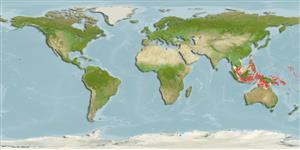>
Gobiiformes (Gobies) >
Gobiidae (Gobies) > Gobiinae
Etymology: Trimma: Greek, trimma, -atos = something crushed (Ref. 45335); meranyx: Name from Greek words 'mera' meaning day, and 'nyx' meaning night, for ‘day-night pygmy goby’, referring to its unique colouration of a black peduncle with twin 'suns' dorsally and ventrally; noun in apposition..
Environment: milieu / climate zone / depth range / distribution range
экология
морской ассоциированный с рифами; пределы глубины 45 - 70 m (Ref. 96671). Tropical
Western Pacific: Indonesia, Papua New Guinea; photographic taken from the Philippines and Vanuatu.
Size / Вес / Возраст
Maturity: Lm ? range ? - ? cm
Max length : 1.9 cm SL (female)
Краткое описание
морфология | морфометрия
колючие лучи спинного плавника (общее число): 7; членистые (мягкие) лучи спинного плавника (общее число): 8; колючие лучи анального плавника 1; членистые (мягкие) лучи анального плавника: 8. This species is distinguished by the following set of characters: a narrow bony interorbital (< 55% pupil width), predorsal midline with 8-9 scales; cycloid scales usually along the upper border of the opercle which may be in up to 3 horizontal rows; 2 (usually cycloid) cheek scales; a very slightly elongate second dorsal spine usually reaching posteriorly to between the base of the spine and the base of the second ray of the second dorsal fin; unbranched pectoral-fin rays; fifth pelvic-fin ray which branches once dichotomously and is 64-85% the length of the fourth ray; a full basal membrane connecting the inner margins of the fifth pelvic fins rays in undamaged specimens; black posterior half of the caudal peduncle with a large white spot dorsally and ventrally just anterior to the procurrent caudal fin rays is unique within the genus (Ref. 96671).
Most specimens of this 'twilight zone' species are reported from the 70 m depth range (though
have been collected as shallow as 45-55 m in the Lembeh Strait). The species do not appear to school or aggregate as with many congeners, but rather are found individually in small caves and crevices, frequently quite deep into the interstices of the reef and only visible using a strong underwater flashlight. Specimens collected were found exclusively on deep reefs sheltered from wave exposure but nonetheless exposed to currents, and although there was frequently significant silt build-up present in the caves in which they sheltered, water visibility was always good because of the significant water flow over the reefs (Ref. 96671).
Life cycle and mating behavior
половая зрелость | размножение | нерест | икра | Fecundity | личинки
Winterbottom, R., M.V. Erdmann and N.K.D. Cahyani, 2014. Three new species of Trimma (Pisces; Gobioidei) from Indonesia. Zootaxa 3838(3):367-384. (Ref. 96671)
Статус Красного Списка МСОП (Ref. 130435)
Угроза для людей
Harmless
Использование человеком
дополнительная информация
народные названиясинонимыобмен веществхищникиэкотоксикологияразмножениеполовая зрелостьнерестSpawning aggregationFecundityикраРазвитие икры
Возраст/РазмерыростЗависимость между длиной и массой телаЗависимость между длинамиРазмерный составморфометрияморфологияличинкидинамика численности личинокпополнениечисленностьBRUVS
ссылкиаквакультура (рыбоводство)особенности рыбоводствастепень растяжениягенетикаElectrophoresesнаследуемостьболезниобработкаNutrientsMass conversion
соавторыизображенияStamps, Coins Misc.звукиCiguateraскоростьтип плаванияжаберная областьOtolithsмозгзрение
инструменты
Специальные отчеты
Скачать в формате XML
ресурсы в Интернет
Estimates based on models
Preferred temperature (Ref.
123201): 26.7 - 29, mean 27.7 °C (based on 16 cells).
Phylogenetic diversity index (Ref.
82804): PD
50 = 0.5000 [Uniqueness, from 0.5 = low to 2.0 = high].
Bayesian length-weight: a=0.01023 (0.00477 - 0.02194), b=3.02 (2.84 - 3.20), in cm total length, based on LWR estimates for this (Sub)family-body shape (Ref.
93245).
устойчивость к внешним воздействиям (Ref.
120179): высокий, минимальное время удвоения популяции до 15 месяцев (Preliminary K or Fecundity.).
Fishing Vulnerability (Ref.
59153): Low vulnerability (10 of 100).
